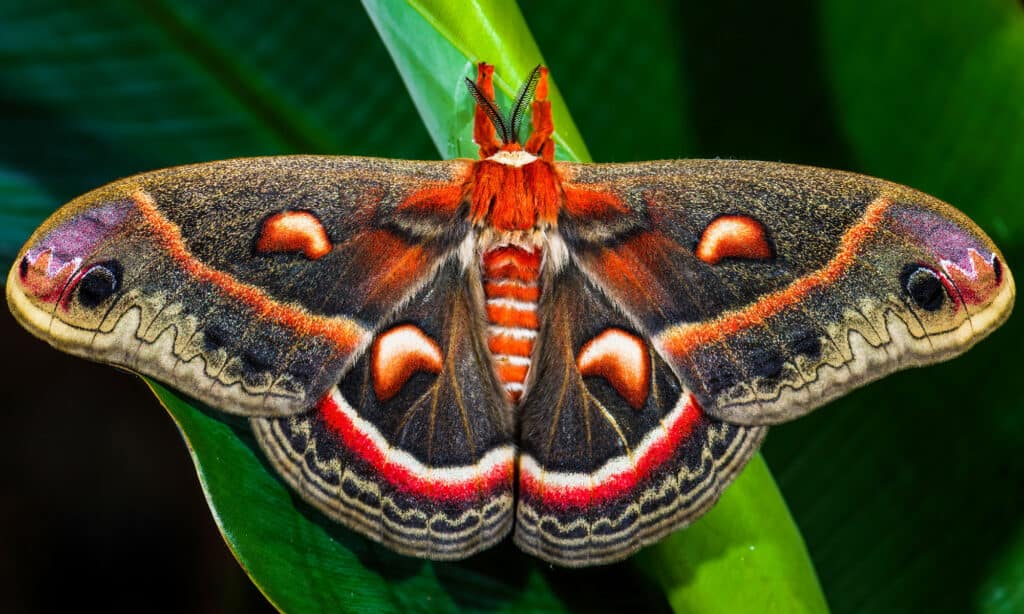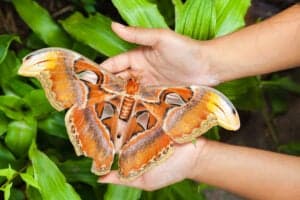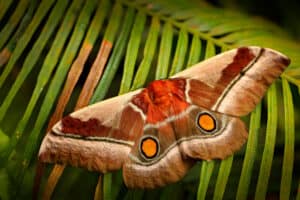Have you ever heard of the cecropia moth? It is the largest moth in North America, with a wingspan about 11-15 centimeters long. It can be found throughout most of the United States. This unique moth species can live up to six months, from egg to adult cecropia.
In this blog post, we take an in-depth look at the cecropia moth, from its appearance, size, origin, habitat, diet, reproduction, and lifecycle. We will also look at the common diseases affecting cecropia moths. Read on to learn more!
Description of the Largest Moth in North America
The cecropia moth (Hyalophora cecropia) is a member of the family Saturniidae, which contains some of the world’s giant moths. It is also known as the robin moth, giant silk moth, or cecropia silk moth.
Though their origins are inconclusive, cecropia moths date back to the first Greek King of Athens, Kekropios, hence their name. The first cecropia moth was discovered in 1758 by Carl Linnaeus.

The males have thinner antennae than females, making them easier to identify in flight.
©Cathy Keifer/Shutterstock.com
These beautiful creatures are known for their remarkable black, red, dark brown, and white coloration. And don’t forget their large size, with wingspans ranging from 5-7 inches long.
It’s effortless to distinguish between the male and female cecropia moth. The males have thinner antennae than females, making them easier to identify in flight.
Cecropia Moth Habitat
Cecropia moths are nocturnal creatures. They inhabit wooded areas across North America, including Canada, Alaska, and Mexico. During spring and early summer, cecropia moths can crowd in lighted areas.
It’s unclear why they are attracted to light. However, some theories claim that artificial lights interfere with the moth’s internal navigation system. In contrast, others assume that the light helps them find their way at night.
They can also inhabit meadows, shrubs, brushlands, fields, and scrub. And since their numbers have dwindled, due to habitat loss, pesticides, pollution, and diseases, cecropia’s impact on the environment is less prevalent.
Appearance
Cecropias moths are stunning creatures that sport various hues. The moth’s body is adorned with a white collar and several stripes of white bands on the abdomen. Their wings have rounded tips and are dark brown with crescent spots.
The largest moth in North America sports a vertical stripe on their wings in black, white, and reddish-orange colors. Columbia silkmoths are similar, but do not have the reddish-orange vertical stripe. This makes it easy to distinguish between the two.
When open, their wings span about 5-7 inches. They possess long feathery antennae. However, the male’s antennas tend to be longer than the female’s antennas.
Size
The cecropia moth’s cocoon is about 5 inches long and 2 inches wide. The moth stays inside the cocoon for the whole winter and emerges as a winged critter in May.
Compared to other moths found in the states, this species is the largest moth, the second largest being the Polyphemus moth.
Lifespan
In the Saturnidae family, cecropia moth is one of the longest-living species, lasting five to six months. During their lifetime, they spend their daytime in dormancy and come alive at night when temperatures are low. During this time, they spread their wings and roam while looking for food and mates.
Cecropia moths can spend several months in their larvae stage. However, once they become winged adults, they only live for two weeks. Their primary purpose is to mate. And this applies to both males and females.
Cecropia Moth Reproduction
Male caterpillars will fly around at night for suitable mates during mating season. The males use their antennae to detect female pheromones secreted through scent glands near the thorax area. And they can detect the females when they are more than a mile away.
After finding a mate, they stay coupled during the day and sometimes in the evening. And at the end of the mating season, they are rewarded with dozens of eggs. The female attaches them to the leaves in small groups.
The eggs hatch within a week or two and then go through different stages before becoming beautiful, winged adults.
Males face danger from spiders. Bolas spiders emit the same pheromones as female Cecropia moths, luring them to their trap.
Cecropia Moth Lifecycle
Cecropia moths have a fascinating lifecycle. It follows a typical annual development pattern, like many other invertebrates. They go from egg to larval stage to pupae, before transforming into adults. And the sad fact is that after having passed through all the stages, an adult cecropia moth lives only for two weeks.
- Egg stage: The female lays about 100 eggs and arranges them in small batches on the leaves or the ground. The eggs are reddish-brown.
- Larvae stage: Note that the larva stage has five instars.
After seven to 14 days, the eggs hatch into black larvae. They significantly damage foliage as they feed on it.
The second larva instar changes color from black to dark yellow and then to yellow. And they continue unreserved feeding.
The third to fifth larva instar are similar in that the larva continues to grow with the body length reaching up to 4.5 inches. And the color changes to bright or sea green. You’ll also notice that their dorsal protrude with black distal spines.
Their thoracic is reddish-orange, their abdomen is yellow, and the sides are pale blue.
- Pupae stage: After the larva stage, the pupa and the moth are large and enclosed in a dark brown silk cocoon attached to the plant’s stem.
- Adult cecropia moth: After the pupa stage, the insect develops into a winged moth about 6 inches long. The moth’s wings are brownish with red hues near the base of the forewing. You’ll also notice red spots with a whitish center on the wings. And the ends are whitish on all wings with a reddish band along the center.
They have a hairy body with red and white bands alternating along the abdomen.
Cecropia Moth Diet
The cecropia caterpillar is primarily herbivorous and feeds on various plants. These include maple, birch, box elder, elm, willow, apple, poplar, and lilac. They have also been known to consume nectar from wildflowers. However, this depends on food availability; there is plenty of trees and shrubs, and then pollen and nectar are spared.
Note that the cecropia moth does not eat; its only life purpose is to mate.
How Does the Cecropia Moth Compare to Other Moths?
The largest moth in North America stands out due to its impressive wingspan, which can reach 7 inches.

Cecropia
moth has a large wingspan reaching 7 inches.
©David Havel/Shutterstock.com
It is even larger than the well-known Polyphemus and luna moth native to the United States, making it a giant species worldwide. You’ll find glaring differences compared to other insect species within the Saturniid family. Most moths tend to be smaller than cecropia moths, with an average size of 3 to 4 inches.
For instance, in contrast to the cecropia moth, the luna moth is green, has a one-week lifespan, is 2 inches long, has a wingspan of 5 inches, and has a one-day mating window.
The Difference Between Male and Female Cecropia Moths
Cecropia moth males have longer feathery antennae than females, which makes them easier to recognize. And they use these antennae to detect female pheromones during the mating stage.
The male cecropia moth has a slender abdomen compared to the female, especially after mating, since the female is full of eggs.
You can distinguish between the two during the pupa stage. The female pupa has a slit in the middle, while in the male, you’ll see a bump on the fifth segment, shaped like a kidney. You can also tell the difference by observing their flying styles. Male cecropia moths fly erratically, and bump into things. On the other hand, the female cecropia moth flies smoothly and gracefully.
Cecropia Moths’ Impact on the Environment
Cecropia moths have various benefits. For instance, they are essential food sources for local birds relying heavily on protein-based diets. They also contribute positively to the environment. They provide organic matter essential for developing new ecosystems through increased soil fertility. And due to their small population, they do not cause too much damage to the foliage during their larva stage.
Fun Facts About the Largest Moth in North America
There are several interesting facts associated with these unique creatures. Their eyesight is incredibly poor, meaning they must rely heavily on their sense of smell to detect mating partners. Their declining numbers can be attributed to the increased use of pesticides.
Diseases Affecting the Cecropia Moth
Like every other animal or insect, the largest moth in North America has threats. They can be infected by diseases or fed on by predators.
Cecropia moths are subject to several diseases transmitted by parasites such as botflies or wasps. These insects lay eggs directly onto young caterpillars while they travel through the foliage.
And after these eggs hatch into larvae, they consume the internal organs and muscles of the cecropia moth caterpillars. Additionally, as mentioned previously, the male cecropia moth faces danger from deceptive bolas spiders that emit the same pheromones as female moths. Their enormous size may also render them a meal to squirrels.
Another danger facing cecropia moths is the pesticides sprayed onto the plants they eat.
The photo featured at the top of this post is © Cathy Keifer/Shutterstock.com
Thank you for reading! Have some feedback for us? Contact the AZ Animals editorial team.







